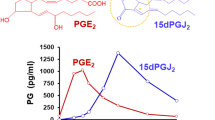Abstract
Macrophages from various sources can be stimulated by a variety of substances to secrete a range of inflammatory mediators and degradative enzymes. The mechanisms involved in the activation and secretory processes are unknown. However, recent evidence suggests that cyclic AMP may play a role in the regulation of neutral protease secretion. Thus, it has been shown that agents known to increase intracellular cyclic AMP levels (cyclic AMP analogues, phosphodiesterase inhibitors, prostaglandin E1 and E2, catecholamines, cholera toxin and, indirectly, glucocorticosteroids) inhibit the secretion of the neutral protease plasminogen activator.
It is speculated that macrophage activation may also be initiated by changes in the steady-state levels of cyclic nucleotides. A decrease in intracellular cyclic AMP and/or an increase in cyclic GMP levels would favour secretion. It is possible that these changes could be brought about by the action of various stimuli to modify the capacity of the macrophage to synthetize or degrade cyclic nucleotides.
Similar content being viewed by others
References
H.R. Bourne, L.M. Lichtenstein, K.L. Melmon, C.S. Henney, Y. Weinstein andG.M. Shearer,Modulation of Inflammation and Immunity by Cyclic AMP, Science184, 19–28 (1974).
M. Kaliner andK.F. Austen,Cyclic Nucleotides and Modulation of Effector Systems of Inflammation, Biochem. Pharmac.23, 763–771 (1974).
P. Davies andA.C. Allison,Secretion of Macrophage Enzymes in Relation to the Pathogenesis of Chronic Inflammation, In:Immunology of the Macrophage (Ed. Nelson; Academic Press 1976), pp. 427–461.
R.T. Dean,Macrophages as Sources of Hydrolases and other Materials in Chronic Inflammation, Eur. J. Rheumatol. Inflamm.3, 11–16 (1979).
J-D. Vasalli, J. Hamilton andE. Reich,Macrophage Plasminogen Activator: Modulation of Enzyme Production by Anti-Inflammatory Steroids, Mitotic Inhibitors, and Cyclic Nucleotides, Cell8, 271–281 (1976).
N. Rosen, J. Schneck, B.R. Bloom andO.M. Rosen,Inhibition of Plasminogen Activator Secretion by Cyclic AMP in a Macrophage-Like Cell Line, J. Cyclic Nucl. Res.5, 345–358 (1978).
Z. Werb, R. Foley andA. Munck,Glucocorticoid Receptors and Glucocorticoid-Sensitive Secretion of Neutral Proteinases in a Macrophage Line, J. Immun.121, 115–121 (1978).
M. Baggiolini, B. Dewald andJ. Schnyder,Effects of Wortmannines, Cyclo-oxygenase Inhibitors and Dexamethasone on Enzyme Secretion by Macrophages, Br. J. Pharmac. (in press).
H.A. Chapman Jr.,Z. Vavrin andJ.B.J. Hibbs,Modulation of Plasminogen Activator Secretion by Activated Macrophages: Influence of Serum Factors and Correlation with Tumoricidal Potential, Proc. natn. Acad. Sci. USA76, 3899–3903 (1979).
S. Gordon, Z. Werb andZ. A. Cohn,Methods for Detection of Macrophage Secretory Enzymes, in:In Vitro Methods in Cell Mediated and Tumour Immunity (Eds. B. Bloom and J.R. David; Academic Press, New York 1976), pp. 341–352.
D.B.P. Goodman, H. Rasmussen, F. DiBella andC.E. Guthrow,Cyclic Adenosine 3′∶5′-Monophosphate-Stimulated Phosphorylation of Isolated Neurotubule Subunits, Proc. natn. Acad. Sci. USA76, 652–659 (1970).
E. Remold-O'Donnel andH.G. Remold,The Enhancement of Macrophage Adenylate Cyclase by Products of Activated Lymphocytes, J. Biol. Chem.249, 3622–3627 (1974).
S.C. Seifert andT.D. Gelehrter,Mechanism of Dexamethasone Inhibition of Plasminogen Activator in Rat Hepatoma Cells. Proc. natn. Acad. Sci. USA75, 6130–6133 (1978).
G. Weissmann andL. Tomas,The Effect of Corticosteroids upon Connective Tissue and Lysosomes, Recent Prog. Hormone Res.20, 215–245 (1964).
S.J. Foster andJ.P. Perkins,Glucocorticoids Increase the Responsiveness of Cells in Culture to Prostaglandin E 1, Proc. natn. Acad. Sci. USA74 4816–4820 (1977).
T.P. Lee andC.E. Reed,Effects of Steroids on the Regulation of the Levels of Cyclic AMP in Human Lymphocytes. Biochem. Biophys. Res. Commun.78, 998–1004 (1977).
H.D. Peters, B.A. Peskar andP.S. Schönhöfer,Glucocorticoids: Effects on Prostaglandin Release, Cyclic AMP Levels and Glycosaminoglycan Synthesis in Fibroblast Tissue Cultures, Naunyn-Schmiedeberg's Arch. Pharmac.296, 131–137 (1977).
F.P. Nijkamp, R.J. Flower, S. Moncada andJ.R. Vane,Partial Purification of Rabbit Aorta Contracting Substance-Releasing Factor and Inhibition of its Activity by Anti-Inflammatory Steroids, Nature263, 479–482 (1976).
G.P. Lewis andP.J. Piper,Inhibition of Release of Prostaglandins as an Explanation of Some of the Actions of Anti-Inflammatory Corticosteroids, Nature254, 3—8—311 (1975).
Y. Floman andU. Zor,Mechanism of Steroid Action: Inhibition of Prostaglandin Synthesis and Release, Prostaglandins12, 403–413 (1976).
R.J. Gryglewski,Steroid Hormones, Anti-Inflammatory Steroids and Prostaglandins, Pharmac. Res. Comm.8, 337–348 (1976).
I.L. Bonta andM.J. Parnham Prostaglandins and Chronic Inflammation, Biochem. Pharmac.27, 1611–1623 (1978).
E. Remold-O'Donnell andH.R. Alpert,Alternation of Hormone-Stimulated Cyclic AMP Synthesis in Guinea Pig Peritoneal Macrophages, Cellular Immun.45, 221–229 (1979).
A. Grunspan-Swirsky andE. Pick,Enhancement of Macrophage Adenylate Cyclase by Microtubule Disrupring Drugs, Immunopharmacology1, 71–82 (1978).
A. Grunspan-Swirsky andE. Pick,Facilitation of Adenylate Cyclase Stimulation in Macrophages by Lectins, Cellular Immun.45, 415–427 (1979).
D. Gemsa, L. Steggemann, J. Menzel andV. G. Till,Release of Cyclic AMP from Macrophages by Stimulation with Prostaglandins, J. Immun.114, 1422–1424 (1975).
K. Bendtzen andR. Klysner,Increased Polymorphonuclear Leukocyte cGMP Levels Induced by the Human Lymphokine, Leukocyte Migration Inhibition Factor (LIF), Immunopharmacology1, 323–330 (1979).
G. Graff, J.H. Stephenson, R.R. Winget andN.D. Goldberg,Oxidative Activation of Guanylate Cyclase by Prostaglandin Endoperoxides and Fatty Acid Hydroxperoxides, Lipids14, 212–228 (1979).
D. Gemsa, M. Seitz, W. Kramer, G. Till andK. Resch, The Effects of Phagocytosis, Dextran Sulphate, and Cell Damage on PGE1 Sensitivity and PGE1 Production of Macrophages. J. Immun.120, 1187–1194 (1978).
Author information
Authors and Affiliations
Rights and permissions
About this article
Cite this article
Foster, S.J. Cyclic nucleotides, possible intracellular mediators of macrophage activation and secretory processes. Agents and Actions 10, 556–561 (1980). https://doi.org/10.1007/BF02024165
Issue Date:
DOI: https://doi.org/10.1007/BF02024165



